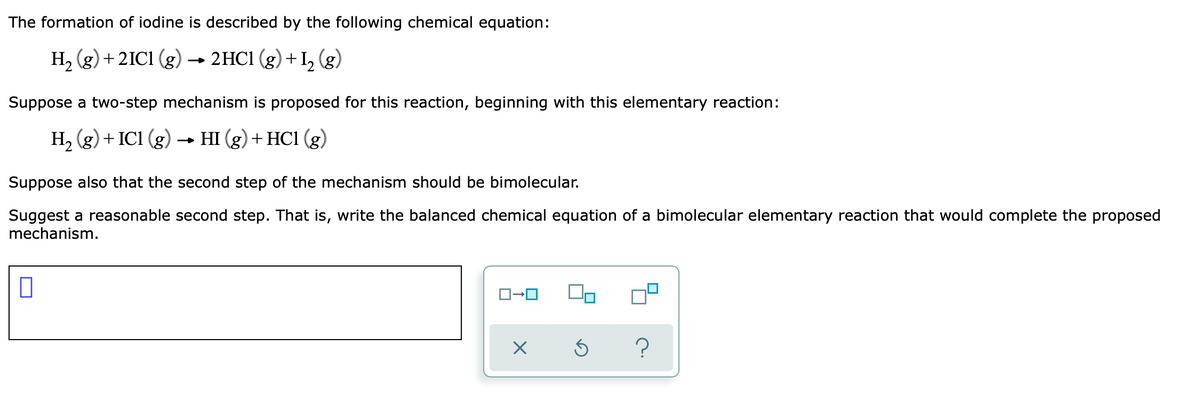The formation of iodine is described by the following chemical equation: H, (g) + 2IC1 (g) → 2HCI (g) + I, (g) Suppose a two-step mechanism is proposed for this reaction, beginning with this elementary reaction: H, (g)+ IC1 (g) –→ HI (g) + HC1 (g) Suppose also that the second step of the mechanism should be bimolecular. Suggest a reasonable second step. That is, write the balanced chemical equation of a bimolecular elementary reaction that would complete the proposed mechanism.
The formation of iodine is described by the following chemical equation: H, (g) + 2IC1 (g) → 2HCI (g) + I, (g) Suppose a two-step mechanism is proposed for this reaction, beginning with this elementary reaction: H, (g)+ IC1 (g) –→ HI (g) + HC1 (g) Suppose also that the second step of the mechanism should be bimolecular. Suggest a reasonable second step. That is, write the balanced chemical equation of a bimolecular elementary reaction that would complete the proposed mechanism.
Chemistry: The Molecular Science
5th Edition
ISBN:9781285199047
Author:John W. Moore, Conrad L. Stanitski
Publisher:John W. Moore, Conrad L. Stanitski
Chapter11: Chemical Kinetics: Rates Of Reactions
Section11.5: Temperature And Reaction Rate: The Arrhenius Equation
Problem 11.9E: The frequency factor A is 6.31 108 L mol1 s1 and the activation energy is 10. kJ/mol for the...
Related questions
Question

Transcribed Image Text:The formation of iodine is described by the following chemical equation:
H, (g) +2IC1 (g)
2HC1 (g) +I, (g)
Suppose a two-step mechanism is proposed for this reaction, beginning with this elementary reaction:
H, (g) + IC1 (g) → HI (g) + HC1 (g)
Suppose also that the second step of the mechanism should be bimolecular.
Suggest a reasonable second step. That is, write the balanced chemical equation of a bimolecular elementary reaction that would complete the proposed
mechanism.
Expert Solution
Step 1
Given
H2 (g) + 2ICl (g) →2HCl (g) + I2 (g)
Trending now
This is a popular solution!
Step by step
Solved in 3 steps with 1 images

Knowledge Booster
Learn more about
Need a deep-dive on the concept behind this application? Look no further. Learn more about this topic, chemistry and related others by exploring similar questions and additional content below.Recommended textbooks for you

Chemistry: The Molecular Science
Chemistry
ISBN:
9781285199047
Author:
John W. Moore, Conrad L. Stanitski
Publisher:
Cengage Learning

Chemistry: Principles and Practice
Chemistry
ISBN:
9780534420123
Author:
Daniel L. Reger, Scott R. Goode, David W. Ball, Edward Mercer
Publisher:
Cengage Learning

Principles of Modern Chemistry
Chemistry
ISBN:
9781305079113
Author:
David W. Oxtoby, H. Pat Gillis, Laurie J. Butler
Publisher:
Cengage Learning

Chemistry: The Molecular Science
Chemistry
ISBN:
9781285199047
Author:
John W. Moore, Conrad L. Stanitski
Publisher:
Cengage Learning

Chemistry: Principles and Practice
Chemistry
ISBN:
9780534420123
Author:
Daniel L. Reger, Scott R. Goode, David W. Ball, Edward Mercer
Publisher:
Cengage Learning

Principles of Modern Chemistry
Chemistry
ISBN:
9781305079113
Author:
David W. Oxtoby, H. Pat Gillis, Laurie J. Butler
Publisher:
Cengage Learning

Chemistry: Principles and Reactions
Chemistry
ISBN:
9781305079373
Author:
William L. Masterton, Cecile N. Hurley
Publisher:
Cengage Learning

Chemistry & Chemical Reactivity
Chemistry
ISBN:
9781337399074
Author:
John C. Kotz, Paul M. Treichel, John Townsend, David Treichel
Publisher:
Cengage Learning

Chemistry
Chemistry
ISBN:
9781305957404
Author:
Steven S. Zumdahl, Susan A. Zumdahl, Donald J. DeCoste
Publisher:
Cengage Learning